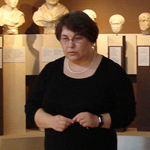

 Dr. Despina Ignatiadou
Dr. Despina Ignatiadou Dr Despina Ignatiadou is Curator of Sculpture at the National Archaeological Museum, Athens. She studied Archaeology at the Aristotle University of Thessaloniki and Conservation of Antiquities at the Institute of Archaeology, University of London.
Her research focuses on the history of glass, classical archaeology and ancient religion and symbolism. She has published extensively on Pre-Roman glass and is co-author of the book Glassworking, Ancient and Medieval: Terminology, technology and typology, A Greek-English, English-Greek Dictionary (Thessaloniki 2008). Her latest book is her PhD thesis on Colorless glass for the elite in ancient Macedonia (Thessaloniki 2013).
The scarcity of glass finds of pre-Roman manufacture in conjunction with the absence of pre-Roman glass-working facilities, gave the early scholars the impression that glass was not worked in ancient Greece. Consequently, the theory evolved that glass objects were imported. The Archaic and Classical core-formed vessels and small objects of colored glass were tentatively attributed to the Phoenician production and led to the establishment of the term Phoenician as a strong conventional name that survives even today. The Classical colorless glass vessels, jewelry and inlays are a rare find as they constitute a very special group of luxury products. When such finds were unearthed in the treasury of Persepolis the myth of the Persian production was created, to be later succeeded by that of the Alexandrian one. Half a century of recent excavations proved the early conclusions wrong and now among other important glass-working traditions, that of the ancient Greece can be considered a pre-eminent one.